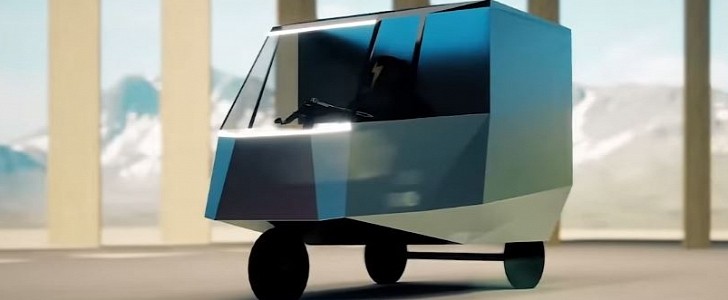It never hurts to daydream. As of this moment, Tesla has its hands full with building new factories, working on new EVs and riding the tallest profit wave ever.
Call this an exercise of the imagination, courtesy of Gali Russel of HyperChange, Alborz Design and Viv: if Tesla were to make rickshaws, they would probably look a lot like the Moonshot Cybershaw concept.
The Cybershaw concept falls in the same category as all the other Cybertruck-inspired concepts we’ve been covering since the November 2019 presentation of the all-electric pickup truck. As such, it’s made from the same cold-rolled stainless steel and retains the angular, slightly misshapen form, but on a much smaller scale. Because this is a rickshaw, which could be described as “cute” vehicles if size is factored in, the Cybershaw doesn’t have a fraction of the Cybertruck’s aggressiveness or physical presence.
What it lacks in the looks department would be compensated for in functionality, the people behind the concept say. For one, this would be an affordable vehicle, starting at just $6,000, which would make it the cheapest Tesla product on the market (not including official merchandise, of course).
Secondly, this would have double functionality: it could be used to haul people (one driver and three passengers in the back) or goods, in which case it would come with 64 cubic feet (1,812 liters) of space in the back. This being a Tesla product, it would use the Tesla Supercharger network for “refills,” but it would also come with a solar-panel roof that would serve as range extender: 10 miles (16 km) per day.
This wouldn’t be much, but the range for a single battery charge would be of 150 miles (241.4 km), which would be enough for city use. Top speed would be of 50 mph (80.4 kph), with a 0 to 42 mph (0 to 67.5 kph) time of 6.9 seconds.
“This has huge potential to disrupt the mobility of people and packages,” the description of the concept video, which you can also see below, reads.
If only it were that easy as writing stuff down to make them happen.
The Cybershaw concept falls in the same category as all the other Cybertruck-inspired concepts we’ve been covering since the November 2019 presentation of the all-electric pickup truck. As such, it’s made from the same cold-rolled stainless steel and retains the angular, slightly misshapen form, but on a much smaller scale. Because this is a rickshaw, which could be described as “cute” vehicles if size is factored in, the Cybershaw doesn’t have a fraction of the Cybertruck’s aggressiveness or physical presence.
What it lacks in the looks department would be compensated for in functionality, the people behind the concept say. For one, this would be an affordable vehicle, starting at just $6,000, which would make it the cheapest Tesla product on the market (not including official merchandise, of course).
Secondly, this would have double functionality: it could be used to haul people (one driver and three passengers in the back) or goods, in which case it would come with 64 cubic feet (1,812 liters) of space in the back. This being a Tesla product, it would use the Tesla Supercharger network for “refills,” but it would also come with a solar-panel roof that would serve as range extender: 10 miles (16 km) per day.
This wouldn’t be much, but the range for a single battery charge would be of 150 miles (241.4 km), which would be enough for city use. Top speed would be of 50 mph (80.4 kph), with a 0 to 42 mph (0 to 67.5 kph) time of 6.9 seconds.
“This has huge potential to disrupt the mobility of people and packages,” the description of the concept video, which you can also see below, reads.
If only it were that easy as writing stuff down to make them happen.






